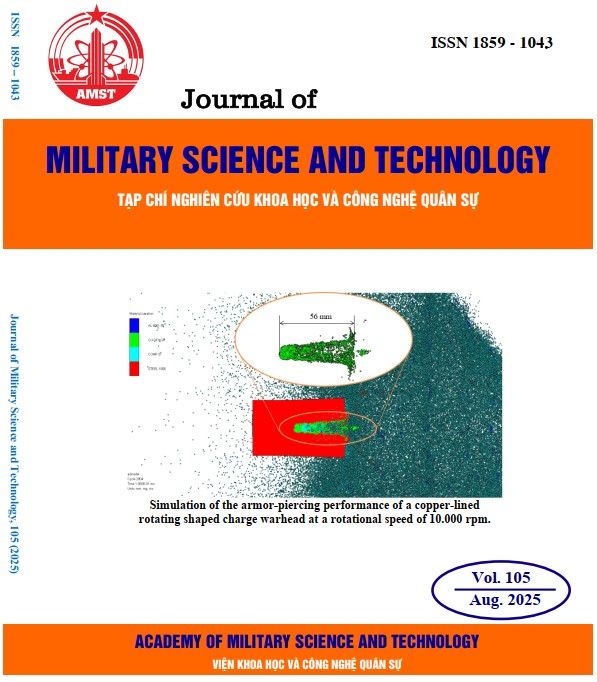Ứng dụng thuật toán SQP trong điều khiển nhóm leader-follower
398 lượt xemDOI:
https://doi.org/10.54939/1859-1043.j.mst.105.2025.11-19Từ khóa:
SQP; DMPC; Dẫn-Theo; Rô bốt di động đa hướng.Tóm tắt
Bài báo đề xuất ứng dụng thuật toán SQP (Sequential Quadratic Programming) để điều khiển nhóm robot di động đa hướng có mô hình Lead-Follower. Phương pháp bao gồm dự đoán động học của toàn nhóm, xây dựng bài toán điều khiển dự đoán mô hình phân tán (DMPC) với hàm chi phí gồm các thành phần duy trì đội hình bám quỹ đạo, tránh va chạm, đồng thời giải bài toán tối ưu hàm chi phí này theo thời gian thực bằng SQP. Trong mô phỏng có sử dụng nhiễu Gauss tác động lên trạng thái và tín hiệu điều khiển để kiểm tra hiệu quả của phương pháp khi triển khai trong thực tế.
Tài liệu tham khảo
[1]. Nocedal, J., & Wright, S, “Numerical Optimization” (2nd ed.), Springer, (2006).
[2]. Zheng, Y., Wang, L., & Yang, G. "Distributed optimal coordination for multi-agent systems with leader–follower structure via a novel SQP method”, Journal: IEEE Transactions on Cybernetics, (2018)
[3]. Wang, Xinghu, Dabo Xu, and Yiguang Hong. "Consensus control of nonlinear leader–follower multi-agent systems with actuating disturbances." Systems & Control Letters 73, (2014). DOI: https://doi.org/10.1016/j.sysconle.2014.09.004
[4]. Javier Alonso-Mora, Stuart Baker and Daniela Rus. “Multi-robot navigation in formation via sequential convex programming”, IEEE/RSJ International Conference on Intelligent Robots and Systems, (2015). DOI: https://doi.org/10.1109/IROS.2015.7354037
[5]. Andrea Carron, Danilo Saccani, Lorenzo Fagiano, Melanie N. Zelinger, “Multi-agent Distributed Model Predictive Control with Connectivity Constraint”, IFAC-PapersOnline 56-2, (2023). DOI: https://doi.org/10.1016/j.ifacol.2023.10.1310
[6]. E.F. Camacho, C.Bordons, “Model Predictive Control “ (2nd ed). Springer, (2006). DOI: https://doi.org/10.1007/978-0-85729-398-5
[7]. Boyd, S., Parikh, N., Chu, E., Peleato, B., & Eckstein, J, “Distributed Optimization and Statistical Learning via the Alternating Direction Method of Multipliers”, Foundations and Trends in Machine Learning, (2011). DOI: https://doi.org/10.1561/2200000016
[8]. Mayne, D. Q., Seron, M. M., & Raković, S. V, “Robust model predictive control of constrained linear systems with bounded disturbances”, Automatica, (2005). DOI: https://doi.org/10.1016/j.automatica.2004.08.019
[9]. J. M. Maestre, R. Negenborn, “ Distributed Model Predictive Control Made Easy”, Springer, (2014). DOI: https://doi.org/10.1007/978-94-007-7006-5
[10]. Tran Thi Minh Dung, “Nghiên cứu về thuật toán đồng thuận Cho hệ thống đa đối tượng”. Journal of Science and Technology – The University of Danang, Vol. 6, No. 103, (2016) (in Vietnamese).
[11]. Trinh Hoang Minh, Nguyen Minh Hieu, “Điều khiển hệ đa tác tử”, Hanoi University of Science and Technology, (2021) (in Vietnamese).
[12]. Nguyen Thi Tuyet Hoa, Nguyen Tuan Minh, “Điều khiển nhóm phân tán cho hệ đa tác tử dựa trên lý thuyết đồ thị cứng ứng dụng trong theo dõi mục tiêu di động”, TNU journal of science and technology, (2023) (in Vietnamese).
[13]. H. Do, H. Nguyen, C. Nguyen, M. Nguyen, and M. Nguyen, “Formation control of multiple unmanned vehicles based on graph theory: A comprehensive review”, EAI Endorsed Transactions on Mobile Communications and Applications, (2022).







